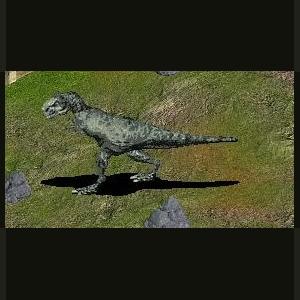About This File
Appalachiosaurus
Appalachiosaurus (pronounced ap-a-LAYCH-ee-oh-SAWR-us; "Appalachian lizard") is a genus of tyrannosauroid theropod dinosaur from the Late Cretaceous Period of eastern North America. Like almost all theropods, it was a bipedal predator. Only a juvenile skeleton has been found, representing an animal over 7 meters (23 ft) long and weighing over 600 kilograms (1300 lb), which indicates an adult would have been even larger. This species is notable as the most completely known theropod from the eastern part of North America.
This dinosaur was named after the region of the central United States known as Appalachia, which also gave its name to the ancient island continent on which Appalachiosaurus lived. Both are named after the Appalachian Mountains. The generic name also includes the Greek word sauros ("lizard"), the most common suffix used in dinosaur names. There is one known species, A. montgomeriensis, which is named after Montgomery County in the U.S. state of Alabama. Both genus and species were named in 2005 by paleontologists Thomas Carr, Thomas Williamson, and David Schwimmer (who is not to be confused with the actor of the same name).
Fossils of Appalachiosaurus were found in central Alabama, from the Demopolis Chalk Formation. This formation dates to the middle of the Campanian stage of the Late Cretaceous, or around 77 million years ago (Carr et al., 2005).
Appalachiosaurus is so far known from only partial remains, including parts of the skull and mandible (lower jaw), as well as several vertebrae, parts of the pelvis, and most of both hindlimbs. These remains are housed at the McWane Science Center in Birmingham, Alabama. There are several open sutures between bones of the skull, indicating that the animal was not an adult. Several elements are crushed, but the specimen is still informative and shows many unique characteristics, or apomorphies. Several of these apomorphies have been identified in the skull, and the claws of the feet show an unusual protrusion on the end closest to the body. A row of six low crests lines the top of the snout, similar to the Asian Alioramus, although most tyrannosaur species exhibit ornamentation to varying degrees on top of the snout. Appalachiosaurus is significantly different and more derived than another early tyrannosaur from eastern North America, Dryptosaurus.
Appalachiosaurus is complete enough to be included in phylogenetic analyses using cladistics. The first was performed before the animal had had even been named, and found Appalachiosaurus to be a member of the albertosaurine subfamily of Tyrannosauridae, which also includes Albertosaurus and Gorgosaurus (Holtz, 2004). The original description also included a cladistic analysis, finding A. montgomeriensis to be a basal tyrannosauroid outside of Tyrannosauridae (Carr et al., 2005). However, Asian tyrannosaurs like Alioramus, and Alectrosaurus were excluded, as was Eotyrannus from England. Earlier tyrannosaurs such as Dilong and Guanlong had not been described at the time this analysis was performed. These exclusions may have a significant effect on the phylogeny. To date, no analysis has been published which includes all known tyrannosauroid taxa.



Recommended Comments
There are no comments to display.
Create an account or sign in to comment
You need to be a member in order to leave a comment
Create an account
Sign up for a new account in our community. It's easy!
Register a new accountSign in
Already have an account? Sign in here.
Sign In Now